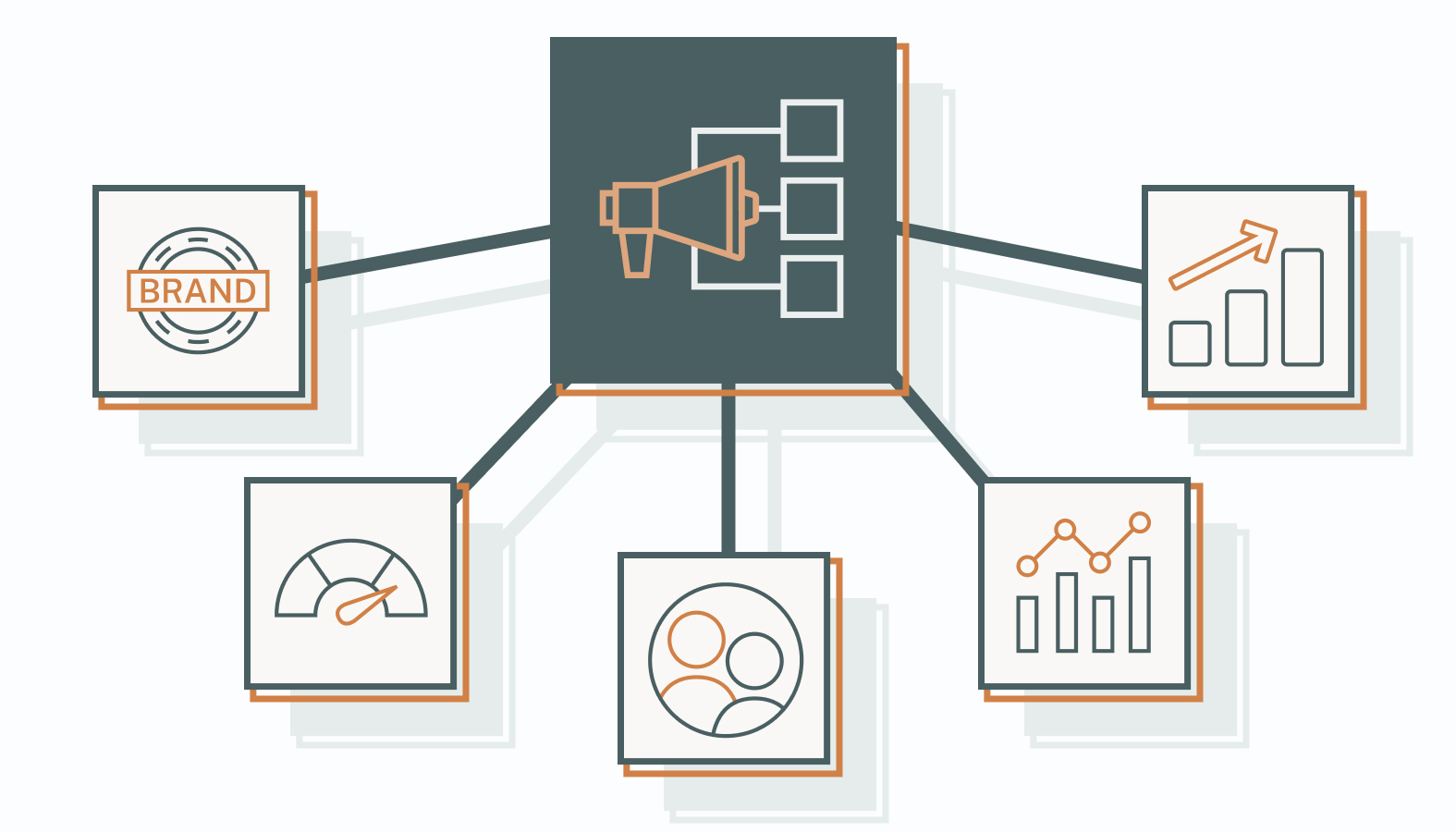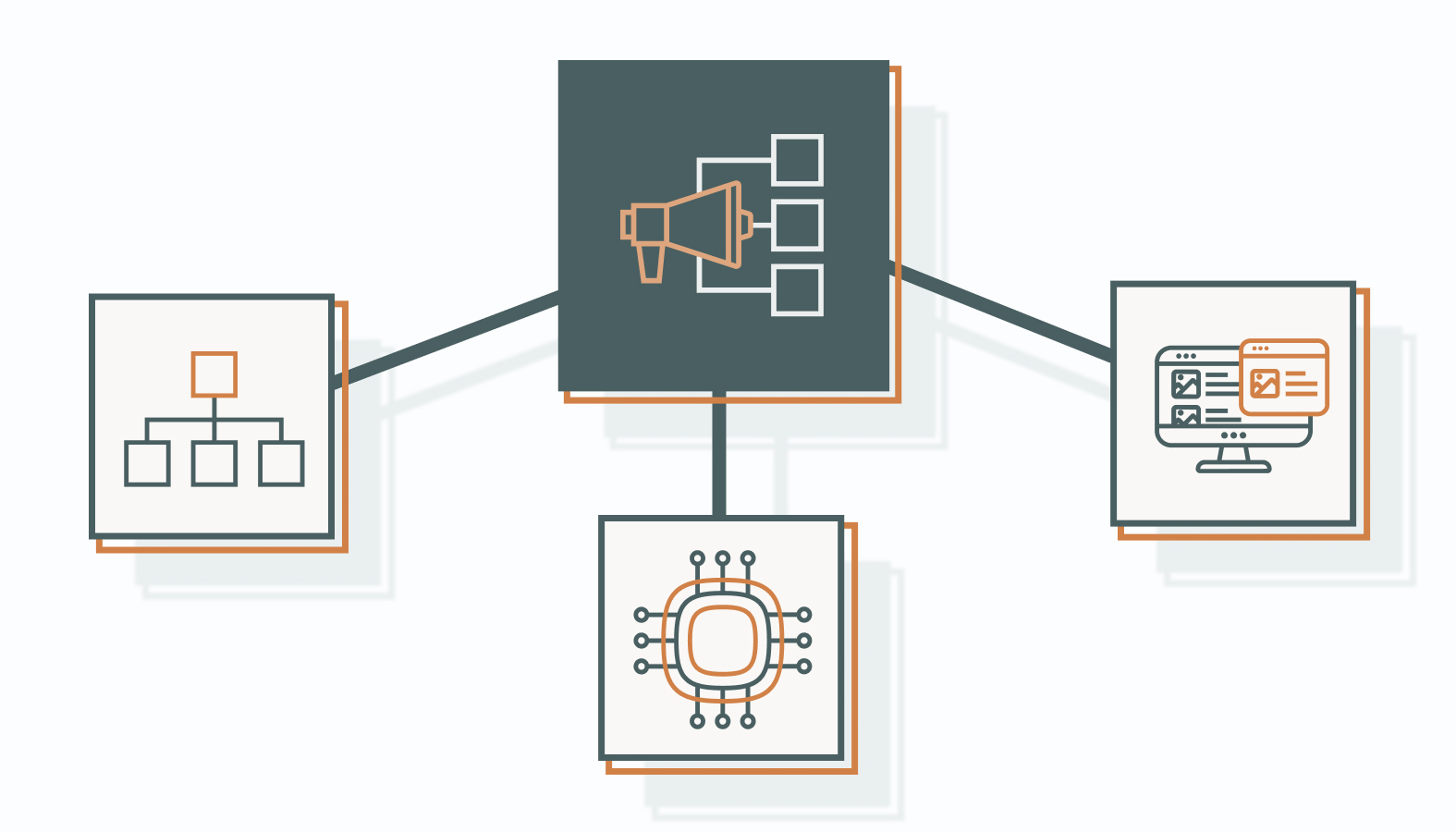In today’s digital age, the battle for consumer attention is fiercer than ever. Brands are bombarded with countless marketing messages, making it increasingly difficult to stand out.
Are you tired of blending into the background?
Imagine a world where your brand is not just seen, but felt. A world where your marketing efforts aren’t just scattered but synergized. A world where your message resonates, converts, and drives growth.
The secret lies in a well-executed integrated marketing campaign. It revolves around creating a cohesive brand experience that captures hearts and minds by strategically combining various marketing channels.
This guide will show you how to maximize the power of integrated marketing.
Unleash Your Brand’s Potential: The Benefits of Integrated Marketing
So, how can integrated marketing help your business?
Imagine a tech startup, “InnovateX,” that’s been struggling to gain traction in the market. Despite launching innovative products and services, their marketing efforts seem disjointed. Their social media posts are inconsistent, their email campaigns are lackluster, and their website doesn’t align with their branding.
As a result, their target audience is confused. They don’t know what InnovateX stands for or what value it offers. This lack of brand clarity hinders their ability to attract and retain customers.
To address this challenge, InnovateX decided to implement an integrated marketing campaign. They developed a unified brand message highlighting their commitment to innovation and problem-solving. This message was then incorporated into all their marketing efforts, from social media to email marketing to paid advertising.
By aligning their marketing channels, InnovateX creates a cohesive brand experience. Every interaction with their audience reinforces their brand identity and values, building trust and loyalty. As a result, they see a significant increase in website traffic, social media engagement, and, ultimately, customer conversions.
This strategy isn’t exclusive to tech startups. Integrated marketing campaigns can benefit both big and small businesses by:
1) Strengthening Brand Consistency
Integrated marketing is the secret sauce to a strong, consistent brand identity. By aligning messaging across all channels, from social media to in-store experiences, you create a seamless brand journey for your customers.
Imagine a customer who sees your brand’s message on Instagram, then visits your website, and finally makes a purchase in-store. If each touchpoint reinforces the same brand values and messaging, it creates a powerful, cohesive experience.
This consistency not only makes your brand memorable but also builds trust. After all, customers are more likely to choose a brand they know and can rely on.
2) Boosting Marketing Efficiency and ROI
An integrated marketing approach operates like a finely tuned engine, enhancing the efficiency of your efforts and delivering higher ROI. By coordinating campaigns across multiple channels, you eliminate redundancies, reduce costs, and maximize the effectiveness of your marketing budget.
For example, creating a single, compelling message that resonates across social media, email campaigns, and paid advertising saves time and resources on content development and amplifies your message’s reach and impact. This unified strategy ensures your audience encounters a consistent narrative, reinforcing your brand and driving better results.
By aligning goals, resources, and tactics, every marketing dollar is spent with purpose, delivering more value and measurable outcomes for your business.
An integrated approach doesn’t just save time—it transforms your marketing into a strategic powerhouse.
3) Expanding Audience Reach and Engagement
Integrated marketing is a strategic multiplier, enabling you to connect with a broader and more diverse audience. By leveraging multiple channels in harmony, you can meet your customers where they are—whether scrolling through social media, watching TV, or shopping in-store.
For instance, launching a new product with a unified campaign that combines TV commercials, social media buzz, email marketing, and in-store promotions amplifies your message. It creates a cohesive and memorable brand experience.
This multi-channel synergy ensures your campaign reaches different audience segments, capturing attention and driving action.
Moreover, incorporating interactive elements and cross-channel promotions—such as contests, personalized messaging, or exclusive offers—deepens engagement and encourages repeat interactions.
An integrated approach broadens your reach and fosters meaningful connections that keep your audience invested in your brand.
4) Leveraging Data for Strategic Insights
Integrated marketing unlocks a wealth of data, empowering you with actionable insights to refine and elevate your marketing strategy.
By analyzing performance across multiple channels, you gain a deeper understanding of your customers’ behaviors, preferences, and decision-making processes.
For example, integrated campaigns allow you to pinpoint which types of content resonate most, which platforms drive the highest engagement, and what factors ultimately influence purchasing decisions. These insights enable you to craft targeted, compelling messaging and allocate resources to the strategies that deliver the best results.
With robust tracking of key metrics and trend analysis, your marketing efforts become dynamic and adaptive. Instead of relying on guesswork, you can make data-driven decisions to continually optimize your campaigns, ensuring they remain relevant, impactful, and aligned with your business goals.
5) Fostering Long-Term Brand Growth
Integrated marketing lays the foundation for lasting connections with your customers, turning them into loyal advocates for your brand. Maintaining consistent engagement across multiple channels creates a seamless and meaningful customer experience that strengthens trust and loyalty over time.
For instance, implementing a loyalty program that rewards repeat purchases or sending personalized emails celebrating milestones can show customers you value and understand them. These thoughtful interactions foster a sense of belonging and deepen their emotional connection to your brand.
When customers feel genuinely appreciated, they’re more likely to stick with your brand and recommend it to others. This natural word-of-mouth advocacy is one of the most powerful drivers of long-term brand growth.
Integrated marketing doesn’t just consider current customers—it also nurtures relationships that thrive well into the future.
Proven Approaches to Integrated Marketing Campaigns
A well-executed integrated marketing campaign ensures that every interaction with your brand, whether online or in-person, is seamless and memorable.
There can be an unlimited number of approaches to these types of campaigns, but these three strategies have been proven to work best:
Merging Digital and Offline Strategies
Combining digital and offline marketing is like having the best of both worlds. By blending these two approaches, you can reach your audience wherever they are and provide multiple touchpoints that reinforce the same messaging.
A successful example of this integration is Coca-Cola’s “Share a Coke” campaign, which combined customized bottles in stores (offline) with social media sharing (digital). This campaign was a masterclass in integrated marketing. The company personalized bottles and encouraged social media sharing, creating an organic buzz both in stores and online.
By harmonizing digital and offline strategies, brands can create engaging and memorable experiences that connect with consumers on different levels.
Creating Unified Social Media Experiences Across Platforms
Consistency across social media platforms is essential for cultivating a strong and recognizable brand identity. A unified message—whether in tone, visuals, or content—helps your audience instantly recognize your brand, no matter where they encounter it.
To manage your social media presence effectively, create a content calendar reflecting your brand’s voice, values, and overall goals. This will help you plan and schedule consistent, relevant, and engaging posts.
Additionally, focus on fostering authentic connections with your audience. Incorporate interactive elements like polls, quizzes, live Q&A sessions, or user-generated content campaigns to encourage participation, engage your followers, and create a sense of community around your brand.
Implementing Multi-Channel Strategies in Retail Marketing
Integrated marketing campaigns are a game-changer for retail, enabling businesses to enhance customer interactions and drive sales through a unified multi-channel approach. By blending email, mobile apps, social media, and in-store promotions, retailers can create a seamless shopping journey that meets customers wherever they are.
For instance, use mobile notifications to inform customers about exclusive in-store discounts or flash sales, enticing them to visit your physical location. Simultaneously, personalized email campaigns can remind shoppers of items left in their online carts, paired with special offers to encourage checkout. Social media can amplify these efforts by showcasing promotions or sharing user-generated content, reinforcing the message across platforms.
An integrated approach, where all these channels are aligned and work together, makes it easier and more enjoyable for customers to interact with the brand. This leads to higher satisfaction and, ultimately, increases sales because customers are more likely to make purchases when they have a positive, seamless experience.
How to Plan Your Integrated Marketing Campaign Strategically
A well-thought-out integrated marketing campaign can help you reach your business goals while maximizing your budget. With the right strategy, you can effectively connect with your target audience.
This guide will show you step-by-step how to create a successful plan.
1) Set Clear Campaign Goals
Setting clear, measurable goals is necessary before embarking on your campaign. This will help you stay focused and track your progress.
For instance, you might aim to increase brand awareness by a certain percentage, generate a specific number of leads within a three-month period, or boost sales by a particular amount in the next quarter. These goals should be SMART: Specific, Measurable, Achievable, Relevant, and Time-bound.
Setting clear goals ensures your campaign aligns with your overall business objectives.
2) Conduct Audience Research and Segmentation
Understanding your audience is indispensable for any effective marketing campaign. Thorough audience research can provide valuable insights into their demographics, behaviors, and preferences.
You can gather this information using various tools and techniques, from traditional methods like surveys and focus groups to modern tools like digital analytics platforms.
Once data is collected, audiences can be segmented based on demographics (age, gender, location), psychographics (lifestyle, values), behaviors (purchase history), and needs. This segmentation allows marketers to tailor their messaging and tactics to resonate more deeply with specific groups, enhancing relevance and impact.
By tailoring your marketing messages to specific segments (or smaller groups), you can create more targeted and effective campaigns that speak directly to their interests and desires.
3) Choose the Right Channels
Choosing the right marketing channels is like picking the perfect tools for the job. You want to use the channels that will most effectively reach your target audience.
Consider your audience’s preferences and behaviors. For example, social media platforms like Instagram or TikTok might be a good choice if you’re targeting a younger audience. Meanwhile, email marketing or direct mail might be more effective for an older demographic.
It’s important to track the performance of your different channels so you can adjust your strategy as needed. By monitoring your results, you can identify what’s working and what’s not, and shift your resources to the most effective channels. This agile approach will help you stay ahead of the curve and maximize your campaign’s impact.
4) Develop Unified Messaging
To build a strong brand, you must set a consistent message across all your marketing channels. This means using the same tone of voice, visuals, and messaging everywhere.
To ensure consistency, you can create a brand style guide that outlines your brand’s voice, mission, and values. This guide can be used to ensure that all your marketing materials, from social media posts to email campaigns, are on-brand.
Maintaining a consistent brand message strengthens your company’s identity, builds trust with your audience, and makes your brand more memorable.
Advanced Integrated Marketing Strategies
In this section, we’ll explore three advanced methods of integrating your marketing efforts.
Unlocking Cross-Departmental Synergy
To succeed with integrated marketing, you must foster a collaborative environment across your entire organization. You can create a more powerful and effective strategy by bringing together teams from sales, product development, customer service, and marketing.
Consider implementing regular cross-functional meetings and utilizing collaborative tools to facilitate this collaboration. Establish clear communication channels and shared goals to ensure everyone is working toward a common objective.
This cross-departmental approach will lead to more cohesive campaigns, improved customer experiences, and better business results.
Leveraging Advanced Marketing Technologies
Technology can be a powerful tool for marketers if done right. By leveraging advanced marketing technologies, you can streamline your operations, personalize your campaigns, and gain valuable insights into your audience.
Here are three examples of must-have tech:
- Customer Relationship Management (CRM) systems help you manage and analyze customer interactions.
- Marketing automation platforms enable you to automate repetitive tasks and deliver targeted campaigns.
- Analytics tools provide valuable insights into your audience’s behavior, allowing you to make data-driven decisions.
By embracing these technologies, you can improve efficiency, enhance customer experiences, and drive better business results.
Crafting Versatile and Impactful Content
Reaching your audience effectively requires creating content that aligns with your brand values and adapts seamlessly to different platforms and audience preferences.
Instead of duplicating the same message, tailor your core idea to fit each channel’s unique format and tone.
For instance, a blog post can be condensed into bite-sized social media updates or transformed into an engaging video. While the format may change, maintaining a unified brand voice ensures your message feels familiar and trustworthy wherever it appears.
By producing engaging and relevant content, you can captivate your audience, build stronger relationships, and encourage them to take meaningful actions—whether sharing your content, making a purchase, or staying loyal to your brand.
Putting Your Integrated Marketing Plan into Action
With your plan in place, it’s time to bring your integrated marketing campaign to life. Success requires teamwork, careful coordination, and tracking performance.
This section covers key strategies to execute your campaign smoothly, from aligning teams to staying adaptable in a changing market.
Aligning Team Efforts and Resources
Successful campaign execution depends on coordinating your team’s efforts and resources. When everyone is aligned, the campaign runs smoothly, with each team contributing to its overall success.
This coordination requires transparent communication, synchronized workflows, and shared resources to ensure every team is working toward the same objectives.
By engaging all relevant departments—marketing, sales, product development, and customer service—you create a unified approach that drives the campaign forward and maintains consistency across all touchpoints.
Monitoring and Measuring Campaign Performance
To ensure your campaign’s success, it’s essential to set clear key performance indicators (KPIs) and metrics. These benchmarks help you gauge whether your campaign is effective and identify areas that need improvement.
Metrics such as conversion rates, customer engagement, and brand awareness provide valuable insights into how well your campaign connects with your audience.
By regularly reviewing these performance indicators, businesses can make data-driven adjustments to optimize results and ensure the campaign achieves its goals.
Ensuring Consistency Across Channels
Maintaining a consistent message across all marketing channels is crucial for building a strong, recognizable brand. This includes using the same logo, color scheme, fonts, and tone of voice across various touchpoints—whether on social media, your website, or print materials.
When your branding is uniform, it helps consumers instantly recognize your brand, no matter where they encounter it.
Aside from using a professional image that resonates with your target audience, consistency also fosters trust and reliability as customers associate your brand with a dependable experience.
The more consistent your messaging, the more memorable your brand becomes. This creates a lasting impression that encourages customer loyalty and strengthens your overall market presence.
Adapting to Feedback and Market Change
It’s important to be flexible and adaptable in today’s fast-paced digital landscape. You can adjust your campaign in real-time by paying attention to customer feedback and market trends.
Consider using tools like A/B testing to experiment with different approaches and measure their effectiveness. By being proactive and responsive, you can ensure your campaign stays relevant to meet evolving customer needs.
Achieving A Unified Future Through Integrated Marketing Excellence
You can transform your brand’s impact and drive lasting growth by embracing an integrated marketing approach. This powerful strategy allows you to:
- Create a Consistent Brand Experience: Deliver a unified message across all channels, building trust and recognition.
- Optimize Marketing Efforts: Streamline your campaigns, reduce costs, and maximize your return on investment.
- Expand Your Reach: Connect with a wider audience and engage them on a deeper level.
- Make Data-Driven Decisions: Leverage insights to refine your strategy and achieve better results.
- Foster Long-Term Relationships: Build stronger bonds with your customers and turn them into brand advocates.
As the marketing landscape evolves, integrated marketing remains a crucial tool for businesses of all sizes.
Ready to take your marketing to the next level?
You now have the tools and strategies to unlock the full potential of integrated marketing campaigns—driving consistency, maximizing ROI, and expanding your audience reach. Every step you take contributes to building a more impactful brand presence.
If you’re wondering how these strategies can be tailored to your unique business needs, we’re here to help. Our team of experts is ready to provide insights and guidance, ensuring your efforts are cohesive, efficient, and results-driven.
There’s no obligation—just an opportunity to explore how integrated marketing can elevate your brand. Schedule a candid conversation with one of our experts today, and let’s discuss how we can help you achieve your marketing goals. Together, we can harness the power of integrated marketing and turn your vision into a success story.










